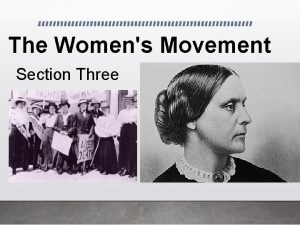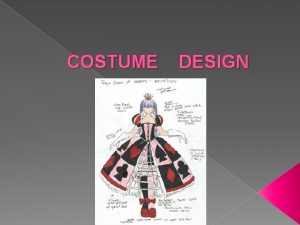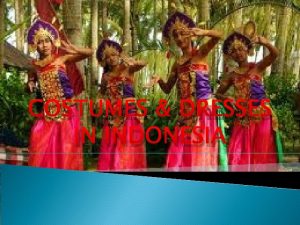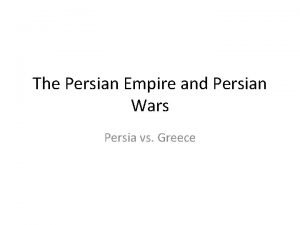L INFLUENCE OF PERSIAN AND INDIAN WOMENS COSTUME
















- Slides: 16

L INFLUENCE OF PERSIAN AND INDIAN WOMEN’S COSTUME Ms. Monisha Kumar Dr. Amita Walia

Introduction The present study contributes o documentation ofthe traditional Persiancostumeswith emphasis on its influence on the Indian costume ( Salwar Kameez) and vice versa.

Objectives The objectives of the study are to: • Make an in-depth study of the ancient Indian women’s costume. • Understand the Persian women’s costume during the medieval period. • Analyze the reciprocal influence of Persian and Indian women’s costume.

Source: http: //distant-relatives-blog. tumblr. com/post/71053744162/fourriver-valley-civilizations-nile

Costume of the Sumerians Mesopotamia Indus Valley Mother Goddess of Mohenjo-Daro Source: http: //www. nationalmuseumindia. gov. in/prod. Collections. asp? pid=34&id= 1&lk=dp 1 Source: http: //womenfromthebook. com/category/sumerians/ Costumes during the Ancient Times

Source: Houston, M. G. Ancient Egyptian, Mesopotamian and Persia Costume and decoration, II edition, London. Vedic & Post Vedic Period Source: Alkazi, R. Ancient Indian Costume, 1983, New Delhi. Persian Costume

Gupta Period The Gupta period is known as the Golden Age or Classical Period in the history. Towards the end of Gupta Empire, cut and sewn garments were observed, but the royalty still used the draped garments especially for women (Alkazi, 1983). Source: Alkazi, R. Ancient Indian Costume, 1983, New Delhi.

Persian Influence Women Costume of Slave Dynasty Kaftan from Ottoman Empire Source: Kahlenberg, M. H. Asian Costumes and Textiles from the Bosphorus to Fujiyama, 2001, I edition, Italy. Review of literature, have revealed that after 1100 AD when Ottoman was predominant in the Middle East & Slave Dynasty was establishing itself in Indian Subcontinent, both men and women wore ‘Kaftan’ originally a Persian garment. Salvar or trouser as a lower garment and turbans.

designer-anarkalis • With the Persian influence, the majority of stitched garments entered India; the Antariya was replaced by the Pajamas (Lower garment). The uttariya still remained though various tunics like Kurtas and angrakhas were added. Source: http: //strandofsilk. com/indian-fashion-blog/stylish-thoughts/flared-flair- • Even though the bifurcated and stitched garments were popularly worn during the slave dynasty, these costumes became more predominated and influenced by the impact of the Mughals.

Traditional Arabic Costume Source: Safia Binzagr Museum- Jeddah, KSA Source: Center For Omani Dress, Muscat, Oman

• Present young generation in the Middle East mostly wears western wear under the Abaya and wears Hijāb and the traditional clothes are only for occasions like weddings and festivals. • They look forward to the latest fashion of salwar kameez, now an important part of the women clothing in the Indian subcontinent, in the Bollywood movies and fashion shows. Source: https: //www. hialbarshadubai. com/blog/dubai/traditionalwear-in-the-uae/ Present Status

Origin of Salwar Kameez

Reciprocal Influence

Conclusion • The cultural identity of any region can be depicted by Fashion and the garments worn by the natives of that region. There has been a considerable change in the cultural identity of both the Indian Subcontinent and the Middle Eastern countries popularly known as the Arab countries. • The study leaves a scope for the future upcoming designers of the Middle East to take pride in their traditional garments and try to revive them in more contemporary and fashionable way as daily or casual wear among the young generation.

/ Indian Subcontinent Source: http: //www. vogue. co. uk/news/2016/01/05/dolce-and-gabbana-hijaband-abaya-collection/gallery/1535797 collection-paris-bombay Source: http: //www. weddinginspirasi. com/2012/01/06/chanel-pre-fall-2012 - Designers Views Middle East

Thank
 Difference between mens and womens soccer
Difference between mens and womens soccer Womens ministry activities
Womens ministry activities Womens rights
Womens rights Late night womens hour
Late night womens hour Aylesbury womens aid
Aylesbury womens aid Womens right
Womens right Womens college kumbakonam
Womens college kumbakonam Womens college kumbakonam
Womens college kumbakonam Womens right
Womens right Womens shelter edmonton
Womens shelter edmonton Women's rights
Women's rights Functions of the uterus
Functions of the uterus Womens history month door
Womens history month door Womens community shelters
Womens community shelters Ballybeen womens centre
Ballybeen womens centre Harijah sivakumar
Harijah sivakumar Womens lacrosse helmets
Womens lacrosse helmets































